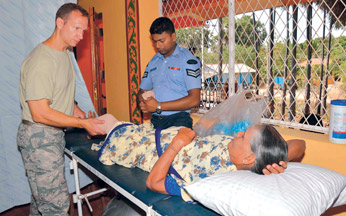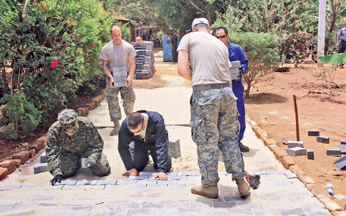'Pacific Angel' ends goodwill mission
In the past week, the Jaffna peninsula was touched by the benevolence
of the 'Pacific Angel'.
Each year the wings of kindness expands to the most needed parts of
the country and this year the villages of the Northern Province were
touched. 'Pacific Angel' is the joint effort of the United States
Pacific Air Forces and the Sri Lanka Security Forces in serving
communities of Sri Lanka through a medical and renovation campaign.
 |
|
Villagers register at
the medical camp |
 |
|
Exchanging knowledge in
patient movement by air |
An annual event that was carried out in silence in the past, 'Pacific
Angel' was launched on August 5 for the people of the Jaffna peninsula.
The project ends today (11).
The first stage of the medical program was conducted at Thikkam
Cultural Hall in Alvai North on August 5 and 6 with international health
professionals and nursing assistance of US Pacific Air Forces comprising
professionals from USA, Australia Bangladesh and the Maldives Armed
Forces.
The Sri Lankan Medical Contingent comprised a 14-member crew
including doctors and consultants from the Ministry of Health, Sri Lanka
Army, Sri Lanka Navy, Sri Lanka Air Force and assistance from Red Cross
members and University students.
The program mainly focused on providing primary health care, physical
therapy, optometry and dentistry for civilians.
The goal of this initiative was to share the knowledge and
experiences of health professionals who represent various countries. A
health education program was also conducted at the assembly area for
civilians.
'Pacific Angel' is the annual exercise of United State Pacific Air
Forces which is conducted in a selected country in the Pacific and Asian
region in collaboration with the Security Forces and civil organisations
of the country. In Sri Lanka the aim of the exercise was to enhance
disaster response and make US assistance in times of disaster to be more
effective.
The program co-hosted a Health Services Outreach and Engineering
Civil Program which was conducted at selected places and underprivileged
schools in the Northern peninsula.
Both activities provided benefits to the local population, while
allowing multi-national responders and Sri Lankans to practice providing
emergency medical assistance and engaging in reconstruction, following a
disaster situation.
The second stage of the medical program was conducted at Saivapragasa
Vidyalayam in Atchuveli on August 8 and 9.
The renovation programs which focused mainly on the renovation of
school buildings and uplifting the infrastructure facilities of
underprivileged schools which were selected on a priority basis.
The renovation program commenced at Punnalaikkadduvan Primary School,
Kuddiyapulam Mixed School and Atchuveli Saivapragasa Vidyalayam on
August 4.
 |
|
Treating a patient |
 |
|
US soldiers renovatine
the pathway in mid day heat |
The works contingent which comprises of seventeen works engineers
from US Pacific Air Forces, along with crew from Sri Lanka Air Force,
Navy and Army.
They were engaged in masonry, carpentry, plumbing, electrical works
and beautification of surroundings of those schools.
This exercise provided a forum for military engineers and technicians
to expand knowledge, share expertise and advance skills through mutual
discussion apart from the primary objective of the exercise which was to
enhance infrastructure facilities and livelihood development of needy
people.
The exercise represents a unique opportunity for military, medical
and engineering professionals to engage on issues of mutual interest,
exchange knowledge and promote excellence in medical and engineering
practices.
In addition to the participants from US Pacific Air Forces (USA and
Australia) and co-host, Sri Lanka, participating nations in the exercise
included Air Force personnel from Bangladesh and the Maldives.
Meanwhile, a Medical Exchange Program of aero medical evacuation with
the US Pacific Air Forces and Sri Lanka Air Force personnel was
conducted at SLAF Base, Katunayake from August 5 to 9.
The program included facilitating a basic understanding of general
aero-medical evacuation principles for rotary and fixed wing aircraft,
the unique requirements for en-route care as it relates to stresses of
flight and briefings and lessons learned from previous evacuations.The
facilitators used standardised Defence Institute of Medical Operations
(DIMO) curriculum for the course concerning Patient Movement by Air in
Humanitarian Assistance, Disaster Response and Military Operations.Apart
from the lessons on theoretical aspects they also took part in a
practical session which involved a C-130 aircraft and MI 17 helicopter.
- Dhaneshi
|


